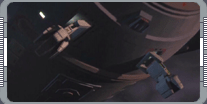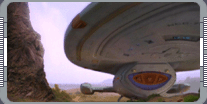
Landing Procedure
Intrepid-class vessels, such as Voyager, are designed to land on a planet's surface.
 The Interpid-class starship is only one of a few that were
designed to be able to land on a planetary surface. Although the proceedure can be done successfully, it is not
intended to be a routine operation and is only done when shuttlecrafts or transporters are not an option.
The landing maneuver has been done a couple times on USS Voyager NCC-74656,
one instance was when the Kazon attacked and commandeered the ship, marooning the crew on Hanon IV in 2372.
Because Federation starships rarely need to land, few pilots have ever performed the landing procedure. It is,
The Interpid-class starship is only one of a few that were
designed to be able to land on a planetary surface. Although the proceedure can be done successfully, it is not
intended to be a routine operation and is only done when shuttlecrafts or transporters are not an option.
The landing maneuver has been done a couple times on USS Voyager NCC-74656,
one instance was when the Kazon attacked and commandeered the ship, marooning the crew on Hanon IV in 2372.
Because Federation starships rarely need to land, few pilots have ever performed the landing procedure. It is,
 The chief engineer then takes the warp core offline and vents plasma from the nacelles, and Main Engineering
however, taught at Starfleet Academy using holodeck simulations. Given reasonable atmospheric conditions, the
landing procedure is relatively straightforward. During landing and takeoff, the ship goes to Condition Blue.
stands by to engage the atmospheric thrusters.
The chief engineer then takes the warp core offline and vents plasma from the nacelles, and Main Engineering
however, taught at Starfleet Academy using holodeck simulations. Given reasonable atmospheric conditions, the
landing procedure is relatively straightforward. During landing and takeoff, the ship goes to Condition Blue.
stands by to engage the atmospheric thrusters.
On the bridge, the pilot puts the atmospheric controls at standby, brings the landing mechanisms online,
and sets the inertial dampers and structural integrity field to maximum. Then the standard glide
trajectory is plotted to take the ship down to the planet's surface. Minor course corrections may be
 necessary, and the inertial dampers have to be adjusted to match the planet's atmosphere. In atmospheric
flight, the ops officer is responsible for maintaining and monitoring EM discharge. During the final
stages of the procedure, the landing struts are released, and the structual integrity field is adjusted
to match the planet's gravity.
necessary, and the inertial dampers have to be adjusted to match the planet's atmosphere. In atmospheric
flight, the ops officer is responsible for maintaining and monitoring EM discharge. During the final
stages of the procedure, the landing struts are released, and the structual integrity field is adjusted
to match the planet's gravity.
|
|
"U.S.S. VOYAGER NCC-74656" - AUGUST 1999 ISSUE 4 STAR TREK: THE MAGAZINE COPYRIGHT OF PARAMOUNT PICTURES.
|